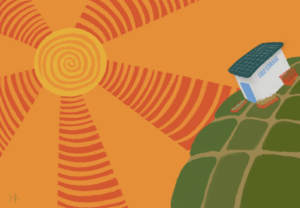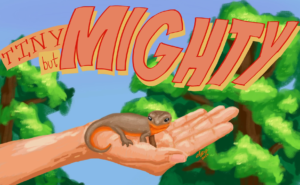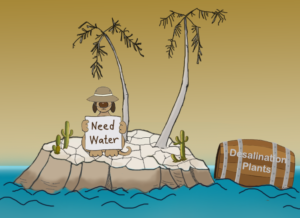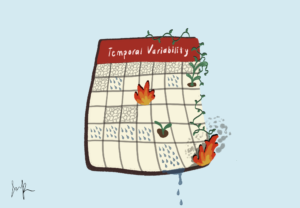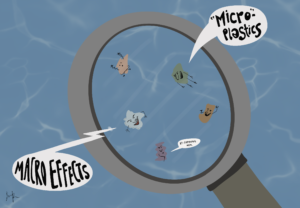
By Elizabeth Saia
If you’re anything like me, you love food. Who doesn’t crave ice cream in the summer or popcorn on movie night? No matter what your favorite snack may be, food will always be an important part of our lives. But did you know that the decisions you make at the grocery store have a significant impact on the environment?
When thinking about sustainable food choices, people often call to mind the fact that they recycle their cans, bottles, and boxes. While recycling will always be an essential way to help the earth, there are many other factors at the grocery store that contribute to your environmental impact.
Picture this: you’re in the dairy aisle, and you need to buy milk. You scan the refrigerator and find yourself overwhelmed by the various types of milk that are available. Should you reach for cow’s milk or a non-dairy option? If you’re looking to decrease your carbon footprint, opt for non-dairy milk instead. In terms of greenhouse gas emissions, the process of producing cow’s milk emits approximately three times more gasses than non-dairy milk. Additionally, the dairy milk industry is responsible for using millions of gallons of water on a daily basis in order to keep their facilities clean and maintain that the cows are fed and hydrated. The production of non-dairy milk, such as oat and soy milk, uses up to twenty times less water.
It is important to remember that cow’s milk is also used to create several other popular dairy products, such as cheese, butter, yogurt, coffee creamer, ice cream, and more. You can find dairy-free alternatives for all of these items as well. In my experience, the plant-based options taste the same, if not better, than the original dairy products. If you are worried about sacrificing great flavor for the sake of decreasing your carbon footprint, you have nothing to fear. Making the switch from dairy to non-dairy is a necessary decision that you will not regret.
Now that you have your favorite plant-based milk in your cart, along with a few other non-dairy products, it’s time to collect the next item on your shopping list: fruits and veggies. At first glance, buying fruits and vegetables should be a no-brainer. It seems impossible that food that grows directly out of the earth could have any negative environmental impacts… right? Wrong. Fortunately, the fruit or vegetable itself is not the issue. It’s the packaging.
While you make your way through the produce section, be aware of the fact that plastic packaging is everywhere. This packaging should be avoided whenever possible. Not only does the creation of such packaging use a considerably large amount of natural resources, but it also contributes to the ever-growing list of greenhouse gas emitters. In addition, this packaging is a type of single-use plastic that will most likely be thrown away after the product is purchased. This poses another problem; the discarded plastic will end up in a landfill, the ocean, or somewhere else where it does not belong. The effects of plastic on the environment are seemingly never-ending. It is responsible for contaminating the soil, freshwater, and countless ecosystems. If you make a conscious effort to avoid purchasing an item wrapped in plastic, you are helping
the planet and its inhabitants immensely. So, when you’re looking to buy your fruits and vegetables, look for items that are free of packaging and skip the plastic bags that are left at your disposal. It’s an easy solution.
On that note, don’t forget to bring your own reusable grocery bags to use at the checkout. Why waste the extra plastic transporting your groceries from the store to your house? It’s not worth it.
We’ve now arrived at the meat department, which is a problematic area for environmentalists. According to the Clean Air Council, the UN estimates that the meat industry is responsible for generating 18% of all global greenhouse gas emissions. As the demand for meat, especially beef, increases each year, the industry’s environmental impact continues to become more and more detrimental. In order to mass-produce such colossal amounts of meat, millions of acres of land are needed to raise and feed the livestock. It is estimated that beef production alone is responsible for 41% of deforestation. As more animals are being bred for the meat industry, more resources such as water and grain are needed to raise these animals until they are old enough for human consumption. Almost 2,000 gallons of water are needed to produce one pound of beef. The same amount of water can be used to produce 50 pounds of vegetables. The meat industry is constantly expanding due to an overwhelming demand for its products. If the industry continues to grow at such a fast rate, we will be in serious trouble.
The amount of meat consumed by the average person each year is simply not sustainable. While the most environmentally friendly solution would be to cut meat from your diet completely, vegan or vegetarian lifestyles are not realistic for most people. The alternative is this: reduce your overall consumption of meat. Try to limit yourself to eating meat only two to three times per week. On the days that you crave a burger, eat a veggie burger to satisfy the craving instead. Meat does not have to be the focal point of every meal. By reducing your weekly intake of meat, you will become less dependent on having it in your diet. If everyone does their part to stop the growth of the meat industry, it would be a big step in the right direction.
As you check off the last item on your shopping list, take a look at all of the products in your cart. Did you make the switch from dairy to non-dairy? Did you avoid the produce with plastic packaging? Did you replace the steak with a vegetarian alternative? If you answer “yes” to any of these questions, you’re not only reducing your own carbon footprint but also playing a significant role in helping to combat climate change. Don’t forget to make a mental note of any packaging that can be recycled once you’ve used it, and remember to use your own reusable shopping bags at the checkout. The grocery store is full of environmentally safe foods. Once you know what to buy and what to avoid, you’ll be well on your way to having a sustainable diet.
Sources:
Ritchie, Hannah. “Dairy vs. plant-based milk: what are the environmental impacts?” Our World in Data. January 19, 2022.
https://ourworldindata.org/environmental-impact-milks#:~:text=Cow’s%20milk%20has%20signifi cantly%20higher,much%20higher%20levels%20of%20eutrophication.
Ritchie, Hannah. “Cutting down forests: what are the drivers of deforestation?” Our World in Data. February 23, 2021. https://ourworldindata.org/what-are-drivers-deforestation
Hannah Ritchie and Max Roser (2017) – “Meat and Dairy Production”. Published online at OurWorldInData.org. Retrieved from: ‘https://ourworldindata.org/meat-production’ [Online Resource]
Delynko, Kristi. “What’s the beef with water?” Denver Water. February 14, 2019. https://www.denverwater.org/tap/whats-beef-water#:~:text=Beef.,the%20way%20to%20the%20t op.
“Meat Industry”. Clean Air Council. https://cleanair.org/public-health/meat-industry/
The views and opinions expressed are those of the authors and do not necessarily reflect nor represent the Earth Chronicles and its editorial board.
